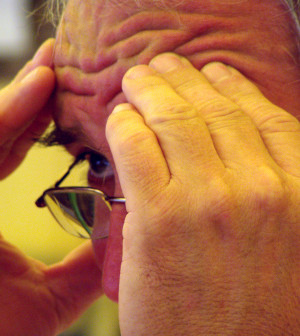- Skip Storing This Everyday Product in the Fridge Door
- Green Tea + B3 Pairing May Boost Brain Health
- Navigating Your Midlife Crisis: Embracing New Possibilities
- City Raccoons Showing Signs of Domestication
- Mapping the Exposome: Science Broadens Focus to Environmental Disease Triggers
- One Week Less on Social Media Linked to Better Mental Health
- Your Brain Changes in Stages as You Age, Study Finds
- Some Suicide Victims Show No Typical Warning Signs, Study Finds
- ByHeart Formula Faces Lawsuits After Babies Sickened With Botulism
- Switch to Vegan Diet Could Cut Your Greenhouse Gas Emissions in Half
Brain Implant Lets ‘Locked-In’ ALS Patient Communicate

A high-tech implant has enabled a paralyzed woman with late-stage ALS (amyotrophic lateral sclerosis) to communicate through brain signaling, researchers say.
The degenerative disease robbed Hanneke De Bruijne, 58, of all voluntary muscle control — including the ability to speak — while leaving her mind intact.
But an experimental implant-software program allows the “locked-in” Dutch woman to type words without assistance.
The brain implant “lets her remote-control a computer with her brain, at home, without any help from researchers,” said study co-author Nick Ramsey.
“She can spell two letters per minute,” said Ramsey, a professor of cognitive neuroscience at University Medical Center Utrecht in the Netherlands. In this way, she can convey her needs to her caregivers, he said.
An estimated 30,000 Americans may have ALS, according to the ALS Association. It is also called Lou Gehrig’s disease after the legendary baseball player who died of the fatal disorder in 1941. People with the disease eventually lose the ability to swallow and breathe.
Ramsey explained that the cutting-edge setup enables the patient to “make brain-clicks with which she selects letters on a keyboard displayed on a computer screen, and that way spell letter by letter.”
One brain specialist applauded the study results.
The Dutch team has “wonderfully achieved a purposefully simple yet important goal,” said Dr. Leigh Hochberg, a neurologist and neuroengineer at Massachusetts General Hospital and Providence VA Medical Center.
“This is great research, not only in its thoughtful focus on a singular goal, but as another important step toward creating powerful, fully implanted neuro-prosthetic systems to help people with paralysis and locked-in syndrome,” said Hochberg.
Diagnosed in 2008, De Bruijne was in a locked-in state of paralysis, apart from one method of communication: the ability to use eye movements and blinking to indicate “yes” or “no” answers distinguishable by standard eye-tracking technology.
Not all ALS patients retain even this capacity. But the study team specifically chose a patient who did in order to have some means of verifying accuracy of the brain-computer interface.
In October 2015, the researchers implanted four electrode strips into a brain region tasked with controlling the muscles of the right hand. The goal: to pick up still-functioning nerve activity, generated whenever De Bruijne tries to move her hand.
These signals are then transferred, via sensors, to an amplifier and transmitter device implanted under her collarbone. This then wirelessly transmits the hand-related nerve activity to a Microsoft Surface Pro 4 tablet device.
In other words, whenever she tries to move her hand, a signal reaches the tablet where it’s translated into a “brain-click” and, ultimately, a typing instruction.
“We hope the system proves to work in more than this first participant,” Ramsey said. He views the effort as “a first step in a series of improvements in device capabilities that will eventually also give less severely paralyzed people back some of their lost motor abilities, such as speech or mobility problems following stroke.”
Now, after a year, the test patient is “quite happy” with the device, Ramsey said, adding that it allows her to communicate with her caregivers in situations where poor lighting renders an eye-tracker ineffective. “The implant always works and makes her feel safe,” he said.
The study results were published Nov. 12 in the New England Journal of Medicine.
More information
There’s more on ALS at the U.S. National Institute of Neurological Disorders and Stroke.
Source: HealthDay
Copyright © 2025 HealthDay. All rights reserved.










